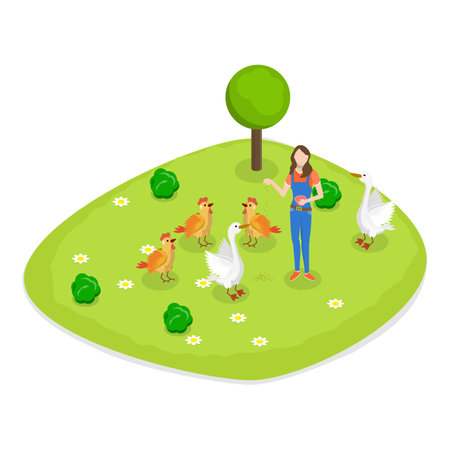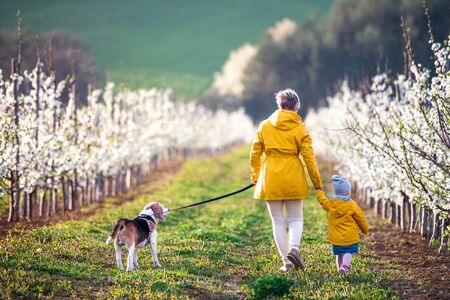Introduction: Britain’s Bountiful Wild Spaces
A warm welcome awaits all who venture into the heart of Britain’s great outdoors. From sprawling parks and ancient woodlands to lively commons and meandering countryside trails, our landscapes offer a treasure trove of natural wonders. These spaces are perfect for families looking to escape the bustle of daily life, connect with nature, and create cherished memories together. Whether you’re accompanied by energetic children eager to explore or a loyal dog ready for adventure, Britain’s wild places promise endless opportunities for wildlife encounters. Setting off on a walk amidst native flora and fauna is more than just a stroll; it’s an invitation to discover the hidden gems of local wildlife while nurturing a sense of wonder in young explorers and furry friends alike.
2. Setting Out: Preparing for Adventure with Young Explorers and Canine Companions
Before you head out for a day among Britain’s wildflowers and woodland creatures, some thoughtful preparation goes a long way in ensuring an enjoyable adventure for everyone—little ones and four-legged friends included. Here are some essential tips to help you plan a family-friendly walk that’s safe, fun, and respectful of the countryside.
Choosing the Right Route
Not all trails are made equal, especially when exploring with toddlers, prams, or energetic pups. Seek out routes that are well-maintained and pram-accessible; many National Trust properties, local parks, and nature reserves offer surfaced paths perfect for buggies. Check online maps or local council websites for accessibility information before setting off.
Family Walk Essentials Checklist
| Item | Why It Matters |
|---|---|
| Snacks & Water | Keeps energy up and prevents grumbles—don’t forget treats for your dog! |
| Dog Lead & Poo Bags | Ensures your pup is under control and the countryside stays clean |
| Weather-Appropriate Clothing | British weather can be unpredictable; pack waterproofs or sun hats as needed |
| First Aid Kit | Handy for scraped knees or minor mishaps along the trail |
| Map or GPS Device | Avoid getting lost, especially in larger reserves or woodlands |
| Pocket Binoculars/Camera | Perfect for wildlife spotting and capturing memories |
Countryside Code: Respecting Nature Together
Teaching children about the Countryside Code helps foster respect for wildlife and fellow walkers. Key points include closing gates behind you, keeping to marked paths, not picking wildflowers, and taking all litter home. For dogs, keep them on leads near livestock and always clean up after them.
Tip for Families:
If your child is walking rather than riding in a buggy, let them set the pace—exploring at their own speed encourages curiosity and reduces tiredness. Planning regular stops to admire bluebells, watch ducks on a pond, or enjoy a snack break turns the journey into an adventure in itself.

3. What to Spot: Britain’s Flora and Fauna under Foot and Paw
One of the true joys of walking through Britain’s countryside is discovering the vibrant array of plants and wildlife that call it home. Whether you’re strolling through ancient woodlands, open meadows, or your local park, there’s always something wonderful to spot with children and dogs in tow.
Seasonal Delights: Bluebells and Beyond
Springtime brings a magical burst of bluebells carpeting the forest floor, especially in places like the Chilterns or Yorkshire woods. Their delicate blue hues are a perfect introduction for children to the wonders of British flora—just remember, bluebells are protected, so encourage little ones (and curious pups) to look, not touch. Later in the year, keep an eye out for wild garlic and foxgloves, each offering their own unique scents and shapes.
Furry Friends on Your Path
The rustle in the undergrowth might just be a shy hedgehog or a cheeky squirrel darting up an old oak tree. Early morning walks are your best chance to spot foxes gliding silently across fields or even urban parks. Encourage children to move quietly and observe from a distance—binoculars can make this even more exciting! With dogs, it’s important to keep them close by or on a lead when wildlife is about, both for their safety and to protect nature’s residents.
Teaching Respectful Exploration
Part of the adventure is teaching kids (and sometimes our four-legged friends) how to be gentle explorers. Remind everyone that picking wildflowers or chasing animals can disturb delicate habitats. Instead, turn wildlife-spotting into a game: who can spot the most birds? Who hears a woodpecker first? Reward patience with stories about woodland creatures and why it’s important we share their space.
A Family-Friendly Checklist
Before you set off, pack a small guidebook or download an app to help identify what you see. Keep a list together—bluebells in spring, squirrels year-round, hedgehogs at dusk—and soon your family will have its own treasure trove of British wildlife memories. Every outing becomes a lesson in kindness and curiosity for both children and pets, making your walks all the richer.
4. Staying Safe: Family and Pet-Friendly Guidelines
Exploring Britain’s stunning countryside with your children and dogs is a rewarding experience, but it’s essential to keep everyone safe while enjoying our wild spaces. Here are some practical guidelines tailored for families and pet owners to ensure a safe adventure among Britain’s diverse flora and fauna.
Spotting Hazards in Nature
Britain’s wildlife and plant life are beautiful but can sometimes pose risks, especially to curious little ones and adventurous pups. Keep an eye out for stinging nettles, which can cause irritation, and be aware of adders—the UK’s only native venomous snake—often found basking in sunny spots from spring through autumn. If you or your dog are bitten by an adder, seek medical or veterinary attention immediately. Teach children not to touch unfamiliar plants or disturb wildlife.
Common Hazards and What to Do
| Hazard | Where You’ll Find It | What To Do |
|---|---|---|
| Nettles | Woodland edges, meadows | Wear long sleeves/trousers; rinse skin with cool water if stung |
| Adders | Heathland, sandy banks, grassy clearings | Keep to paths; don’t let dogs explore dense undergrowth; seek help if bitten |
| Litter/Sharp Objects | Parks, picnic areas, popular trails | Supervise children closely; check ground before sitting or playing |
Avoiding Livestock Encounters
The British countryside is home to many grazing animals such as sheep and cattle. While these animals are usually docile, it’s best to admire them from a distance. Always keep dogs on a lead near livestock—even the friendliest dog can startle farm animals. Remind children not to approach or feed any animals in fields.
Livestock Safety Tips:
- If you feel threatened by cattle, let your dog off the lead so it can run to safety.
- Stick to marked footpaths and close all gates behind you.
Understanding UK Dog Control Laws
Britain has specific laws regarding dogs in public places that every owner should know. On open access land (such as moors and heaths), dogs must be kept on leads between 1 March and 31 July (to protect ground-nesting birds), and at all times near livestock. Some areas may have Public Spaces Protection Orders (PSPOs) requiring dogs to be on leads or excluding them altogether—look out for local signage.
| Location Type | Dog Lead Rules |
|---|---|
| Countryside/Fields with Livestock | Always on a lead |
| Parks/Open Spaces (No Livestock) | Off lead allowed unless otherwise stated; under control at all times |
| Nature Reserves/Coastal Paths | Check signs; seasonal restrictions may apply |
By following these simple guidelines, you’ll help ensure your walks are both enjoyable and safe for every member of the family—including your four-legged friends!
5. Making Memories: Fun Activities and Nature Games
Exploring Britain’s wild spaces with your little ones and furry friends isn’t just about the walk itself—it’s about turning each outing into an adventure packed with laughter and learning. There are plenty of simple British nature trails perfect for families, whether you’re wandering through a bluebell wood or rambling across heathland. To make every walk extra special, try adding fun activities that spark curiosity while helping children respect the countryside.
Scavenger Hunts to Spark Curiosity
One of the most exciting ways to engage children on a walk is with a nature scavenger hunt. Create a list of items commonly found along British paths—think acorns, sycamore seeds, feathers, or even spotting a robin or a squirrel. Give each child a small bag or basket (and don’t forget one for your dog’s treats!), then set off to see who can tick off the most items. This not only keeps children interested but also encourages them to observe their surroundings closely.
Simple Trail Games for All Ages
Nature games bring the landscape to life. Try “I Spy” with a twist, focusing on colours or shapes in the scenery, such as “I spy something green and spiky” (hello, holly bush!). For older kids, play “Nature Bingo”—make cards featuring British wildlife and plants like foxes, oak leaves, daisies, or crows. Whoever gets a row first wins a homemade treat at the next rest stop!
Respecting Wildlife While Having Fun
It’s important to remember that we’re visitors in these wild spaces. Teach children (and remind ourselves) to watch animals from afar and avoid picking flowers or disturbing habitats. Encourage gentle voices and slow movements when observing birds or insects, so everyone—including your four-legged family members—can enjoy the magic of British flora and fauna without causing harm.
By turning every walk into an opportunity for discovery, you’ll be creating lasting memories and nurturing a lifelong love for nature in your children—and maybe even your dog! These simple games and activities mean every family stroll becomes an adventure worth remembering.
6. Community Spirit: Joining Local Nature Walks and Groups
One of the loveliest ways to enjoy Britain’s wildlife with your family and four-legged friends is by joining local nature walks and community groups. Across the country, many organisations such as The Wildlife Trusts, RSPB, and local councils host regular rambles and events that warmly welcome families and well-behaved dogs. These outings offer a fantastic chance to explore new areas, learn about native flora and fauna from knowledgeable guides, and meet like-minded neighbours who share your enthusiasm for the great outdoors.
Family- and Dog-Friendly Rambles
Britain’s network of public footpaths, commons, and green spaces provides endless opportunities for accessible walks suitable for children of all ages and most dog breeds. Many groups specifically tailor their routes to be pram-friendly or avoid livestock fields so everyone feels included. Look out for “buggy walks” or “toddler treks” in your area—these are perfect for little legs and usually involve plenty of stops for wildlife spotting or a good old-fashioned picnic.
Wildlife Trust Events
The Wildlife Trusts regularly organise seasonal events ranging from dawn chorus strolls to bat-spotting evenings. They often provide hands-on activities for kids, like pond-dipping or mini-beast hunts, making conservation fun and educational. Dogs are typically welcome on leads, especially when walking through nature reserves where ground-nesting birds might be present. Check your local Trust’s calendar for upcoming events—you’ll find everything from woodland wanders to hedgerow explorations.
Getting Involved in Conservation
If you’re keen to give back while exploring the countryside, there are plenty of ways to get stuck into community conservation efforts. Many groups run monthly litter picks, habitat restoration days, or wildlife surveys where families (and their canine companions) can lend a hand. It’s a brilliant way for children to develop a sense of stewardship for the natural world—and it often ends with a well-earned cuppa at the village hall! From planting wildflower meadows to maintaining hedgerows, every effort helps keep our beloved landscapes thriving.
By participating in these group activities, you not only nurture a lifelong love of nature in your children but also strengthen your ties to your community. So pop on your wellies, grab the dog lead, and discover how rewarding it can be to walk side-by-side with others who cherish Britain’s wild beauty just as much as you do.
7. Winding Down: British Traditions for the Ending of an Outdoor Day
After a joyful day exploring Britain’s lush countryside, spotting wildlife, and letting your dogs and children stretch their legs, there’s nothing quite like embracing cherished British traditions to wind down. It’s not just about the walk; it’s about how we round off the adventure together, making memories that linger long after muddy boots have been kicked off at the door.
The Classic Cuppa
No British outdoor escapade is truly complete without a comforting cup of tea waiting at home—or even better, poured from a thermos while you’re still out on the trail. Whether you prefer builder’s tea, Earl Grey, or a soothing herbal blend, sharing a warm drink with family is a gentle way to transition from outdoor excitement to cosy indoor comfort. Don’t forget a biscuit or two for dunking—custard creams and digestives are always crowd-pleasers!
Chippy Tea: A Family Favourite
For many families, especially after an energetic ramble, there’s nothing more satisfying than stopping by the local chippy for some good old-fashioned fish and chips. Wrapped in paper and sprinkled with salt and vinegar, this classic treat is perfect for enjoying together—perhaps in the car with windows open to let in the fresh country air or around the kitchen table recounting the day’s adventures. It’s simple, hearty, and deliciously British.
Bringing Nature Indoors
Why not bring a little of your wildlife walk home? Children love collecting pinecones, interesting leaves, or wildflowers (where permitted) as natural souvenirs. These treasures can spark post-walk conversations about what you’ve seen and learned, helping everyone appreciate nature even more while you relax together.
Story Time and Snuggles
To end your day on a tranquil note, gather as a family—dogs included!—for story time. Share tales about British woodland creatures or simply recall favourite moments from your own wildlife encounters. This quiet ritual helps children wind down emotionally and physically, reinforcing the bond between family members and deepening their connection to Britain’s great outdoors.
Whether it’s with a steaming mug of tea or crispy chips wrapped in paper, these small but meaningful traditions turn every wildlife adventure into a cherished family memory. After all, in true British style, it’s not just where you wander—it’s how you come home together that matters most.


